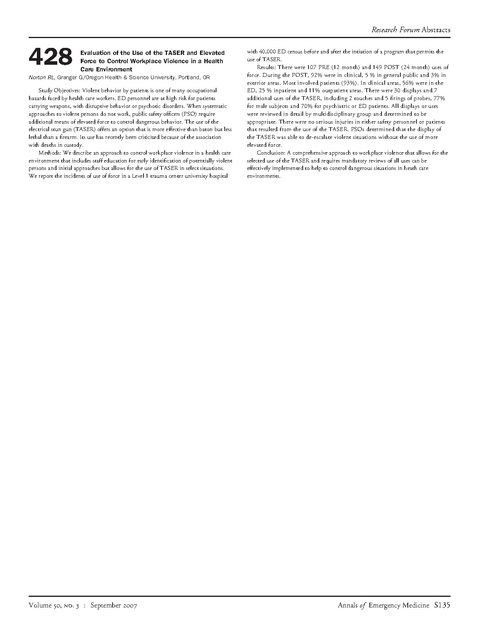Taser Workplace Violence in Healthcare Environment 2007
Download original document:

Document text

Document text
This text is machine-read, and may contain errors. Check the original document to verify accuracy.
Research Forum Abstracts 428 Evaluation of the Use of the TASER and Elevated Force to Control Workplace Violence in a Health Care Environment Norton RL, Granger G/Oregon Health & Science University, Portland, OR Study Objectives: Violent behavior by patients is one of many occupational hazards faced by health care workers. ED personnel are at high risk for patients carrying weapons, with disruptive behavior or psychotic disorders. When systematic approaches to violent persons do not work, public safety officers (PSO) require additional means of elevated force to control dangerous behavior. The use of the electrical stun gun (TASER) offers an option that is more effective than baton but less lethal than a firearm. Its use has recently been criticized because of the association with deaths in custody. Methods: We describe an approach to control workplace violence in a health care environment that includes staff education for early identification of potentially violent persons and initial approaches but allows for the use of TASER in select situations. We report the incidents of use of force in a Level 1 trauma center university hospital Volume , . : September with 40,000 ED census before and after the intiation of a program that permits the use of TASER. Results: There were 107 PRE (12 month) and 149 POST (24 month) uses of force. During the POST, 92% were in clinical, 5 % in general public and 3% in exterior areas. Most involved patients (93%). In clinical areas, 56% were in the ED, 25 % inpatient and 11% outpatient areas. There were 30 displays and 7 additional uses of the TASER, including 2 touches and 5 firings of probes, 77% for male subjects and 70% for psychiatric or ED patients. All displays or uses were reviewed in detail by multidisciplinary group and determined to be appropriate. There were no serious injuries in either safety personnel or patients that resulted from the use of the TASER. PSOs determined that the display of the TASER was able to de-escalate violent situations without the use of more elevated force. Conclusion: A comprehensive approach to workplace violence that allows for the selected use of the TASER and requires mandatory reviews of all uses can be effectively implemented to help to control dangerous situations in heath care environments. Annals of Emergency Medicine S135





